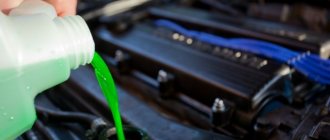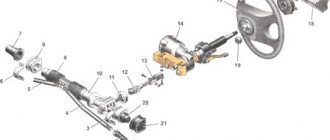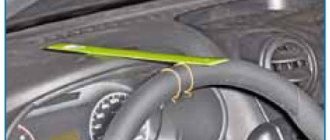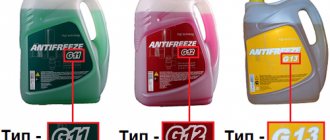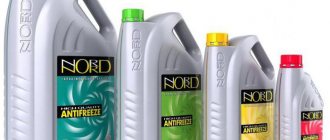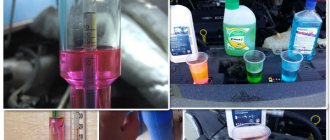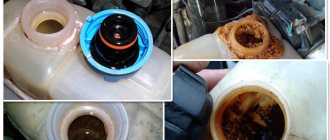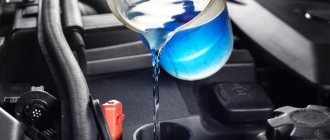Having chosen and purchased an antifreeze fluid for the cooling system, every car enthusiast wants it to actually have the properties stated on the label.
According to recent studies, the share of counterfeit products in the antifreeze liquid market ranges from 40 to 50%. Despite the nice plastic container and neatly made stickers on it, there may be a liquid inside that only vaguely resembles domestic antifreeze or foreign antifreeze. Where is the guarantee that the inside of the canister is not colored water, flavored with battery electrolyte, or water with added sugar or salt?
Why is counterfeit dangerous?
Even if the counterfeit antifreeze still contains some part of ethylene glycol and it does not freeze but crystallizes as the temperature drops, it is unlikely that the counterfeiters bothered to add special anti-corrosion additives to its composition that envelop the non-freezing liquid with a protective film.
Consequently, an aggressive liquid, which is a mixture of water and alcohol, will immediately begin to corrode parts of the engine cooling system. It is unlikely that the engine will withstand at least one season of operation in such conditions.
It is almost impossible to check the presence of protective additives at home, but anyone can find out whether an antifreeze liquid can cope with the cold.
Litmus paper
By moistening the litmus paper with the coolant, the quality of which needs to be determined, and then comparing the color it acquires with a special color scale, it will not be difficult to determine its pH with sufficient accuracy.
If there is no such scale, it doesn’t matter; the approximate acid-base balance of antifreeze can be determined “by eye.” Coloring litmus pink will indicate that there is an excess of acid in the liquid being tested (pH ranges from 1 to 5), and this is direct evidence of counterfeiting.
The blue color of litmus paper will indicate a pronounced alkaline environment with pH > 10, therefore such antifreeze or antifreeze is also a fake, and of disgusting quality.
If the litmus turns green, you know that this is a decent quality antifreeze with an acid-base balance of pH ranging from 7 to 9.
Hydrometer
In addition to measuring the density of the electrolyte, modern aerometers can determine the freezing point of antifreeze. Such hydrometers have a scale graduated in degrees next to the density scale.
Test freezing
Having collected 100-150 ml of the test liquid into a small plastic bottle, you need to squeeze the bottle a little before tightening the cap, releasing the air from it - suddenly the antifreeze turns out to be fake and after freezing it will crush the plastic container.
Istchonik
Did you like the article? Subscribe to the channel to stay up to date with the most interesting materials
1016 June 2020
According to the author. A very common question on my website is how to check antifreeze or antifreeze for quality? Is it fake or not, does it correspond to the declared characteristics, or is it better not to put it in your car?
Moreover, it is advisable to do the process itself at home without resorting to any complex processes. I have an answer for you + a useful video version below (you could say a life hack). Without delay, let's get started...
Antifreeze or antifreeze are made on almost the same principle. They may differ in various additives, but the base is almost always the same, it is Ethylene glycol or Propylene glycol (the simplest alcohols) + distilled water. BUT there are always negligent manufacturers or simply outright counterfeits that will not bring anything good to your car (namely, the cooling system)
Heat test
You can check the quality of antifreeze by heating it. Regular manufacturers claim that their composition will withstand + 105, +110 degrees and will not boil.
You will need a tile, a container (either glass or metal), and a thermometer (that can withstand high temperatures).
Next, heat the liquid and watch when it boils.
If the process started at + 80, + 95 degrees Celsius, this is very bad! A good result starts from + 105 degrees
When antifreeze or antifreeze boils at low values, this may indicate low-quality alcohol in the composition, or no alcohol at all, but more on that later.
The MINUS of such a test is that it is not advisable to do it at home, so as not to inhale the fumes.
Test by fire
After antifreeze or antifreeze begins to boil, it is worth checking them for fire. It’s better not to check with a regular lighter; you need an open source of fire, preferably various types of burners
The thing is that low-quality products (or rather their vapors) can ignite. If you bring the fire over the evaporation (when the liquid is on the “slab”) and they light up, it is better to refuse the purchase
Most likely, a low-quality base was used, not the same components that were included in the original formula.
Of the minuses , again, it’s better not to do it at home (it won’t take long to burn down the apartment).
Cold check
The most commonplace test of antifreeze for quality is to freeze it. We take the bottle and just leave it in the freezer. If you have a large canister, pour into a small container (no need to freeze all 5 liters).
The liquid should not freeze; it is usually written on the packaging up to what temperature it works.
What is important is that it should not thicken; it happens that it does not freeze completely, but crystals begin to form in it, even if the values are not too low. You should also refuse such antifreeze
The MINUS of this verification option is that not all refrigerators have freezers with readings of -30 degrees. And as a rule, many coolants can operate up to -30, -35 degrees.
What is the danger of too little or too much coolant?
The coolant from the radiator goes through hoses and enters the engine to maintain its temperature at optimal values. If there is too little antifreeze, or there is none at all, then the engine will not cool down, but will overheat. This is fraught with dire consequences.
It is important at this point to check that there is no leakage. If there is a leak, the coolant level will drop constantly. The condition of the substance should also be checked. This can be done using litmus paper. It is necessary to compare the color of the strip with the scale on the packaging.
Checking antifreeze with soda
This is an old but working method; they told me about it at the service station (when I worked there). By the way, you can check TOSOL this way, because as I wrote above, they have the same base .
What exactly is the point? Look, as a rule, “scorched liquids” are made on the basis of acids, and not simple alcohols.
If you properly dilute the acid with water, then such a composition will also not freeze at extremely low values, and up to -30, it will work easily. You just need to add dye to disguise it as normal antifreeze.
BUT why do they do this? It's simple, it's a matter of benefits - ethylene glycol and especially propylene glycol are expensive, acid prices are 3 - 4 times lower, so that's the benefit for you. Moreover, very often it is not cheap liquids that can be counterfeited, but, say, branded ones (linked to the car brand).
SUCH ANTI-FREEZE (ANTIFREEZE) will have a very negative impact on the cooling system as a whole, it will simply begin to corrode everything inside, starting from the block, the block head, the gasket between them, then radiators, pipes, and the “pump” in the end.
This is precisely why there is a test with soda - as you and I know, it reacts with acid. Pour a little test liquid (say into a plastic cup), throw in a little soda.
If nothing happens (no reaction) and it falls to the bottom, it means there is alcohol in the base. But if the reaction is violent, foam is released with hissing , and there is NO sediment at the bottom! We refuse such antifreeze, this is just a counterfeit product.
Literally anyone can do this test at home, and there is no need for complex heating and freezing. As a rule, if a liquid foams, it will boil at lower temperatures.
I showed in my video how to check with soda, I recommend everyone to watch it.
Source
Why do you need to check antifreeze?
It is recommended to check the car's coolant level twice a year - before the start of the summer and winter seasons. But this recommendation is somewhat incorrect, because the cooling system performs a very important function - maintaining the optimal temperature regime of the power plant. If there is not enough antifreeze, this is fraught with very serious problems. Therefore, it is better to check the coolant level every time you open the hood of the car, since this operation is simple and takes a couple of minutes.
Checking the level every time the owner looks into the engine compartment almost completely eliminates missing the moment when there is not enough antifreeze in the system. A reason to check the fluid level in the cooling system may also be an increased engine temperature while driving.
Coolant
Antifreeze is an important component of the radiator. Antifreeze has two main functions:
ATTENTION! A completely simple way to reduce fuel consumption has been found! Don't believe me? An auto mechanic with 15 years of experience also didn’t believe it until he tried it. And now he saves 35,000 rubles a year on gasoline! Read more"
- Protection of a running engine from overheating.
- Preventing coolant from freezing in winter.
The industry has standards for the production of antifreeze. The following classes are distinguished:
The first two groups are the hardiest, because the substances they contain are characterized by high concentrations. This allows the liquid to retain its properties even at negative temperatures of 80 degrees Celsius.
The G11 type has more modest performance - it can withstand up to 40 degrees of cold. It is also characterized by a green or blue color.
Antifreeze also functions as antifreeze, but is intended for domestic cars. It is also divided into classes. They produce three main types:
The numerical value demonstrates the critical negative temperature at which the antifreeze remains operational. For example, for grades A40 and A65 - minus 40 and 65 degrees, respectively. AK is a concentrated composition that should be diluted with water. The characteristics of the mixture depend on the ratio. Let's say, with an equal proportion (50% concentrate in liquid), antifreeze can crystallize at approximately minus 30 degrees Celsius.
How to check correctly?
Now about how to check the antifreeze level.
Cooling systems in different cars are slightly different; some have an expansion tank that controls the level, while others do not. In cars whose cooling system includes this reservoir, checking the level is very simple. The tank is usually made of light plastic, and the antifreeze has a certain color. There are also marks on the tank wall indicating the minimum and maximum levels. Therefore, to check the fluid level, you don’t even need to unscrew the cap; you just need to look at the level on the wall of the tank and compare it with the marks.
In cars whose cooling system does not include a tank, topping up and level control is done through the neck located on the radiator. That is, we unscrew the radiator cap and look at the level.
Now some features of the test. It is performed only on a cold and idle engine, for a number of reasons. When heated, antifreeze expands, so when monitoring the level in the tank, the quantity data will be incorrect.
As for cars in which the fluid is checked in the radiator, checking when the engine is hot can lead to injury. The fact is that after heating, pressure forms in the system, and if you remove the radiator cap, there is a high probability of hot antifreeze splashing out through the neck, so it is very easy to get burned. It is best to check the level in the morning, before the trip. The engine will cool down completely overnight, and the level readings will be most accurate.
conclusions
It is best to fill the cooling systems of foreign cars G13 class . The manufacturer promises high heat transfer and long service life. For five years, the car owner may not look into the expansion tank with this antifreeze, unless, of course, there is a leak in it. For domestic cars, regular antifreeze class G11 . This coolant will ensure stable operation of your car.
How much antifreeze should there be?
If you check the tank, then the optimal level will be between the “Min” and “Max” marks. If the fluid is at the “Min” level or below, the power plant will not have enough fluid even after heating and expansion. Air may be sucked into the system, which, after heating, will only increase the pressure in the system, causing the engine temperature to be elevated and possibly squeezing out the liquid from the reservoir or causing one of the system pipes to break off. But if the level is at “Max” or higher, then after heating the excess antifreeze will simply flow out of the tank.
In those cars where antifreeze is poured into the radiator, there is also a mark on the neck, but this only indicates the normal level. It is usually located at the bottom of the neck. This is where you need to navigate.
A low level of liquid in the cooling system carries the risk of: increased temperature of the power plant and its overheating, increased pressure in the system when heated, and the possibility of splashing due to air entering the system.
Probable leak locations
Where can antifreeze go? It is still a liquid, so it can evaporate when heated. To make evaporation less intense, the tank or radiator is tightly closed with a lid. But complete blockage is also not allowed, so there are bypass valves in the lid.
They are needed to relieve pressure in the system if it has risen above the critical norm. It is through this valve that antifreeze evaporates, especially in the summer season. It is very hot in the summer, and if you drive in a traffic jam, the cooling system will not have time to fully remove heat from the engine; it will operate at an elevated temperature. In this case, the antifreeze heats up more than normal, part of it goes into a gaseous state (steam), increasing the pressure in the system, and when the pressure rises above normal, the steam will be released through the valve.
Antifreeze may also leak due to a leak in the system or a crack in one of the rubber pipes. Because of this, the coolant will simply leak out through a leak or crack. In this case, it is very easy to detect a leak - by drips on the pipes and traces of liquid on the asphalt under the car while parked.
The most unpleasant leak is due to a breakdown of the cylinder head gasket (cylinder head). As a result of the breakdown, the cooling system channel is connected to the cylinder, or the crack leads outward. It is very dangerous if a breakdown connects the channel to the cylinder. Not only will the liquid “fly out into the pipe” in the literal sense, but if the repair is untimely, a “water hammer” may occur due to the large amount of antifreeze in the cylinder, and this is already fraught with serious problems, since as a result of this effect the destruction of the piston is possible, connecting rod bend.
It is noteworthy that a cylinder head gasket failure is usually a consequence of engine overheating due to insufficient antifreeze.
Consequences of a cylinder head gasket failure
What and how much should I add?
Finally, about what kind and how to add antifreeze. It is necessary to top up only when the engine is cooled down in order to know the level accurately; when it is heated due to expansion, it will not be possible to accurately determine the level. It is necessary to top up to the mark in the radiator, and if there is none, then almost to the edge of the neck; the excess will be squeezed out through the cap when heated. The tank is topped up to the level located between the marks.
Only the antifreeze that is filled should be poured into the system. Mixing different types of antifreeze is not allowed. If you don’t have liquid on hand to top up, you can use distilled or plain clean water. But it is important to take into account that adding water will significantly reduce the freezing threshold of antifreeze, so you can add it only in the summer, and before the winter period, completely change the fluid in the system.
We looked at how to check the coolant level, how to add antifreeze, and what problems a lack of it in the system can cause. If you periodically monitor the level and, if necessary, replenish it, the cooling system will not fail at the most inopportune moment and will ensure the optimal temperature of the power plant.
Coolant Autoleek Share:
Electrolytic corrosion is a “disease” of metal surfaces
The level of protection of the metal parts of the car cooling system from electrolytic corrosion, which can be caused by dirty, long-used antifreeze, or a poorly manufactured product, is shown by an electronic multimeter .
One of its probes must be lowered into the coolant poured into the radiator, and the second one must be grounded by attaching it to any metal surface.
If the device shows less than 150 mV , this means that the antifreeze is clean and ready for use for some time. Indicators above 150 mV indicate that the liquid has already developed protective lubricating and anti-corrosion additives. 300 mV or more indicates the need to urgently change the antifreeze.
How to check antifreeze (antifreeze)
Antifreeze is a type of antifreeze , a liquid that is used to cool a car engine. It is used because it is highly resistant to low temperatures, which is very helpful during winter driving. The suitability of antifreeze depends on its density. The problem is that over time, antifreeze loses its frost resistance due to a decrease in its density. How to determine when antifreeze needs to be replaced? There are many ways. Among them: litmus tests, “advanced” neighbor, service station. But I would like to share the most, in my opinion, economical and no less accurate way of determining the density of antifreeze .
What you will need:Hydrometer Car Antifreeze in the radiator
- Step 1
To determine the density of antifreeze, we need a car hydrometer - a device for determining the density of a liquid. The fact is that previously hydrometers were produced only with a scale for determining the density of the electrolyte. So, at this time, hydrometers with two scales are already widespread in car dealerships - a scale has been added to determine the freezing point of antifreeze in °C. This is what we will use.
- Step 2
- Step 3
Having pressed the hydrometer bulb, we splash the antifreeze back into the radiator. We screw on the radiator cap and close the hood. After use, the hydrometer must be rinsed with running water, dried and packaged in a plastic container or placed out of the reach of children.
Antifreeze or antifreeze?
This division of coolants into antifreeze and antifreeze exists only in Russia. The origin and history of antifreeze have already been repeatedly described in various media. However, do not neglect the coolant. Thus, according to Arteco, up to 22% of all breakdowns are directly, and 40% are directly or indirectly related to the engine cooling system. Therefore, paying proper attention to cooling and choosing the right coolant can help save money and time. Antifreeze or antifreeze - which is better? Such a question is not only posed incorrectly, but also does not imply a clear answer. This is the same as asking: “who is bigger: a hippopotamus and a hippopotamus?” Whatever you call him, it won’t make him any less. Same with antifreeze and antifreeze. Because it's the same thing. Yes, there are different manufacturers, different concentrations, colors, different quality - but the concept of antifreeze and antifreeze mean absolutely the same thing - non-freezing coolant. It is a fairly common opinion that antifreeze is a high-quality imported coolant, and antifreeze is a domestic one liquid, inferior in quality to imported ones. This opinion is fundamentally incorrect, since many domestic manufacturers call their product antifreeze and this is quite justified, and among them there are also those who are not clean. Here you have a quality imported product. And you can’t show anything: they wanted antifreeze, they got antifreeze, but the fact that there is a misunderstanding in the head “can’t be applied to the case.” The situation is the same with antifreeze: the offers on the market are very different. You can purchase both outright hack work disguised as antifreeze, and high-quality goods.
If your car requires good preventive maintenance or the engine is worn out, then pay attention to XADO additives and technology. After assessing the pros and cons of using additives and other XADO components, you can decide on the advisability of using them for yourself.
Using a hydrometer is easy, but not always correct
Another parameter of the coolant is its density , and checking it is the most popular way among drivers to make sure that the antifreeze meets the standard . This check is done using a car hydrometer . This device is a plastic bottle with a scale indicating the freezing temperature and a rubber hose and a bulb attached to its neck. Thanks to this design, the fluid to be tested can be taken directly from the radiator . The operating principle of the device is based on Archimedes' law. The indicator is the line of contact of the aerometer rod with the collected liquid.
The green range on the scale indicates that the antifreeze crystallizes in the range from -30 to -400 C. Red indicates a partial loss of the properties of the tested liquid and the crystallization temperature is -20 to -300 C. The yellow range corresponds to a temperature from -10 to -200 C . The blue color warns of the need to immediately replace the antifreeze in the car, since it has completely lost its protective properties.
However, it should be noted that checking with an aerometer does not provide one hundred percent protection against counterfeiting. Many manufacturers, knowing about this method, achieve the required density of the product produced using cheap ingredients (acids, sugar, salts). In such liquids, technical parameters are very quickly lost, and it will freeze and boil like ordinary water .
